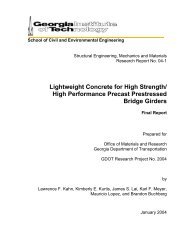Concrete Crack Damage - Expanded Shale & Clay
Concrete Crack Damage - Expanded Shale & Clay
Concrete Crack Damage - Expanded Shale & Clay
You also want an ePaper? Increase the reach of your titles
YUMPU automatically turns print PDFs into web optimized ePapers that Google loves.
<strong>Expanded</strong> <strong>Shale</strong> & <strong>Clay</strong><br />
Minimize Compromises. Maximize Durability.<br />
txiesc.com |<br />
sales@txiesc.com<br />
<strong>Concrete</strong> <strong>Crack</strong> <strong>Damage</strong> –<br />
A Thing of the Past?<br />
General Facts:<br />
Early age concrete cracking and autogenous shrinkage can<br />
be minimized and in some cases completely eliminated and<br />
the service life greatly extended through the use of internal<br />
curing. By incorporating small quantities of prewetted<br />
lightweight aggregate throughout the concrete, the curing<br />
process is enhanced and extended.<br />
The photo above demonstrates internal curing with the<br />
TXI intraCure process. These are side by side field tested<br />
slabs shown 20 hours after placement. The slab on the<br />
left utilizes the intraCure process and the slab on the<br />
right uses conventional concrete.<br />
<strong>Concrete</strong> <strong>Crack</strong> <strong>Damage</strong> – A Thing of the Past?<br />
You may have been told in the past that concrete cracks, that’s a fact and there is nothing<br />
that can be done to stop it. That is yesterday’s news. Now there is a new technology<br />
available called internal curing that can minimize or even eliminate certain types of<br />
cracking and boost the life of your concrete by years.<br />
<strong>Concrete</strong> cracks create clear paths that allow chlorides and other harmful substances to<br />
corrode the reinforcing steel and damage the concrete. In the winter months, those<br />
same cracks contribute to freeze and thaw damage. The result is reduced life expectancy<br />
of concrete structures and pavements. Today, with the use of internal curing, you can<br />
considerably reduce this type of damage.<br />
What is internal curing?<br />
The American <strong>Concrete</strong> Institute (ACI 2010) defines internal curing as “supplying water<br />
throughout a freshly placed cementitious mixture using reservoirs, via pre-wetted<br />
lightweight aggregates, that readily release water as needed for hydration to replace<br />
moisture lost through evaporation or self-desiccation.” Simply said, internal curing is a<br />
practical way of reducing plastic, thermal, autogenous and drying shrinkage cracking.<br />
The results of a study published by Cement and <strong>Concrete</strong> Composites state, “The use of<br />
internal curing can increase service life of high performance concrete bridge decks by<br />
23 years, mainly due to the prevention of initial cracking and reduction in chloride<br />
diffusion.”<br />
continued<br />
References | weblinks<br />
“Internal Curing – Constructing More Robust <strong>Concrete</strong>” – www.txiesc.com/internal-curing-constructing-more-robust-concrete.htm | “Benefits of Internal Curing on Service Life and Life-Cycle Cost of High Performance <strong>Concrete</strong> Bridge<br />
Decks - A Case Study” published in Cement and <strong>Concrete</strong> Composites (March 2010). – http://www.txiesc.com/benefits-of-internal-curing-on-service-life-and-life-cycle-cost-of-high-performance-concrete-bridge-decks-a-case-study.htm |<br />
<strong>Expanded</strong> <strong>Shale</strong>, <strong>Clay</strong> and Slate Institute’s internal curing section – http://www.escsi.org/Default.aspx | TXI <strong>Expanded</strong> <strong>Shale</strong> & <strong>Clay</strong>’s internal curing page – http://www.txiesc.com/internal-curingspecified-density.htm
<strong>Expanded</strong> <strong>Shale</strong> & <strong>Clay</strong><br />
Minimize Compromises. Maximize Durability.<br />
txiesc.com |<br />
sales@txiesc.com<br />
continued<br />
<strong>Concrete</strong> <strong>Crack</strong> <strong>Damage</strong> –<br />
A Thing of the Past?<br />
Want to know more?<br />
The latest information will change your expectations about concrete and provide some<br />
valuable tools for translating those expectations into specifications for more sustainable,<br />
longer lasting concrete. If you are looking to improve the quality of your concrete, you can<br />
learn more about the details and benefits of internal curing by clicking on the following links:<br />
“Internal Curing – Constructing More Robust <strong>Concrete</strong>”<br />
(January 2012).<br />
published in Structure Magazine<br />
“Benefits of Internal Curing on Service Life and Life-Cycle Cost of High Performance <strong>Concrete</strong><br />
Bridge Decks - A Case Study” published in Cement and <strong>Concrete</strong> Composites (March 2010).<br />
You can also find many great resources at <strong>Expanded</strong> <strong>Shale</strong>, <strong>Clay</strong> and Slate Institute’s<br />
curing section and TXI <strong>Expanded</strong> <strong>Shale</strong> & <strong>Clay</strong>’s internal curing page.<br />
internal<br />
Give it a try on your next project, you will reap the benefits of increased durability and a<br />
significantly longer life for your concrete.<br />
TOP A photo of the cracking that occurred when<br />
using a ‘Conventional Bridge Deck Mixture” in<br />
Monroe County Indiana, after one year in service.<br />
ABOVE The currently ‘<strong>Crack</strong> Free’ Internally Cured<br />
<strong>Concrete</strong> Bridge Deck in Monroe County Indiana<br />
after one year in service















